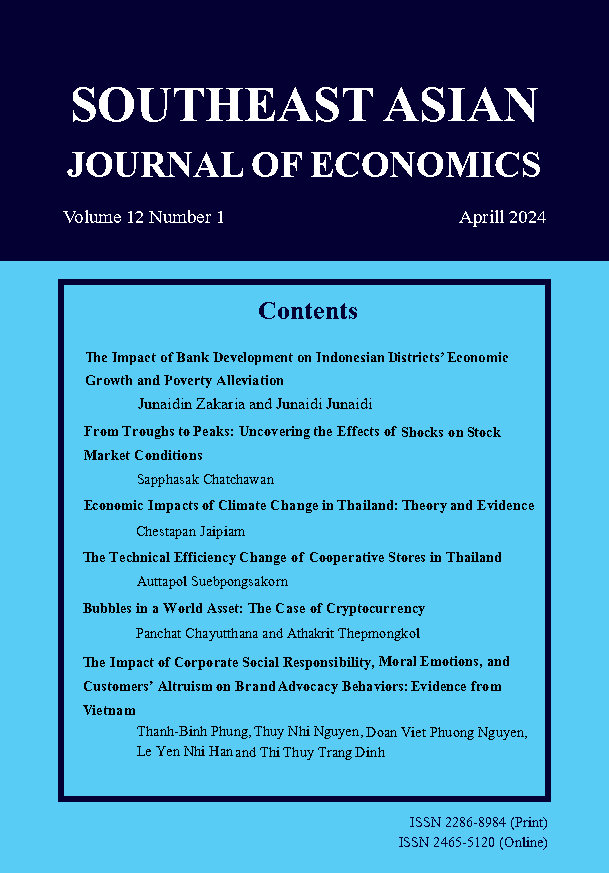From Troughs to Peaks: Uncovering the Effects of Shocks on Stock Market Conditions
Keywords:
asset prices, inflation, stock market conditionsAbstract
I classify stock market conditions into normal, bull, and bear markets and examine the impacts of various shocks on stock market conditions over the period from 2005 to 2020 on the Stock Exchange of Thailand. Inflation shocks cause bear market episodes, while shocks to dividend growth and real stock market returns drive the stock market into bull phases. Investors can benefit from adjusting their investment strategies based on current stock market conditions.In addition, inflation shocks are significant for capital market stability, especially during the Global Financial Crisis. Effectively implementing policies to control expected inflation is a promising approach to promoting capital market stability during financial crises.
References
Ahuja, A., Mallikamas, T., & Poonpatpibul, C. (2003). Asset price bubble and monetary policy: identification and policy response under inflation targeting. Bank of Thailand Symposium.
Airaudo, M., Nisticò, S., & Zanna, L. F. (2015). Learning, monetary policy, and asset prices. Journal of Money, Credit and Banking, 47(7), 1273–1307.
Bekaert, G., & Engstrom, E. (2010). Inflation and the stock market: Understanding the “Fed Model”. Journal of Monetary Economics, 57(3), 278-294.
Blanchard, O. J. (1985). Debt, deficits, and finite horizons. Journal of political economy, 93(2), 223-247.
Bordo, M. D., Dueker, M., & Wheelock, D. C. (2007). Monetary policy and stock market booms and busts in the 20th century. FRB of St. Louis Working Paper No(2007).
Bordo, M. D., Dueker, M. J. & Wheelock, D.C. (2008). Inflation, Monetary Policy and Stock Market Condition. NBER Working Paper, No.14019.
Bullard, J. B., & Schaling, E. (2002). Why the Fed should ignore the stock market. Review-Federal Reserve Bank of Saint Louis, 84(2), 35-42.
Campbell, J. Y., & Vuolteenaho, T. (2004). Inflation illusion and stock prices. American Economic Review, 94(2), 19-23.
Carlstrom, C. T., & Fuerst, T. S. (2007). Asset prices, nominal rigidities, and monetary policy. Review of Economic Dynamics, 10(2), 256-275.
Castelnuovo, E., & Nistico, S. (2010). Stock market conditions and monetary policy in a DSGE model for the US. Journal of Economic Dynamics and Control, 34(9), 1700-1731.
Christiano, L., Ilut, C.L., Motto, R. & Rostagno, M. (2010). Monetary Policy and Stock Market Booms. NBER Working Papers No. 16402.
Clarida, R., Galí, J. & Gertler, M. (2000). Monetary Policy Rules and Macroeconomic Stability: Evidence and Some Theory. The Quarterly Journal of Economics,115(1), pages 147-180.
Dueker, M. (2005). Dynamic forecasts of qualitative variables: a Qual VAR model of US recessions. Journal of Business & Economic Statistics, 23, 96–104.
Dueker, M., & Assenmacher-Wesche, K. (2010). Forecasting macro variables with a Qual VAR business cycle turning point index. Applied Economics, 42, 2909–2920.
Gyntelberg, J., Loretan, M., Subhanij, T., & Chan, E. (2014). Exchange rate fluctuations and international portfolio rebalancing. Emerging Markets Review, 18, 34-44.
Maheu, J. M., & McCurdy, T. H. (2000). Identifying Bull and Bear Markets in Stock Returns. Journal of Business & Economic Statistics, 18(1), 100–112.
Maheu, J. M., McCurdy, T. H., & Song, Y. (2012). Components of Bull and Bear Markets: Bull Corrections and Bear Rallies. Journal of Business & Economic Statistics, 30(3), 391–403.
Modigliani, F., & Cohn, R. A. (1979). Inflation, rational valuation and the market. Financial Analysts Journal, 35(2), 24-44.
Nisticò, S. (2012). Monetary policy and stock-price dynamics in a DSGE framework. Journal of Macroeconomics, 34(1), 126-146.
Pagan, A. R. & Sossounov, K.A. (2003). Simple Framework for Analyzing Bull and Bear Markets. Journal of Applied Econometrics,18(1), 23-46.
Pavabutr, P., & Yan, H. (2007). The impact of foreign portfolio flows on emerging market volatility: evidence from Thailand. Australian Journal of Management, 32(2), 345-368.
World Bank. (2018). Global Economic Prospects, January 2018: Broad-Based Upturn, but for How Long?. The World Bank.
Yaari, M. E. (1965). Uncertain lifetime, life insurance, and the theory of the consumer. The Review of Economic Studies, 32(2), 137-150.
Downloads
Published
How to Cite
Issue
Section
Categories
License
Copyright (c) 2024 SOUTHEAST ASIAN JOURNAL OF ECONOMICS

This work is licensed under a Creative Commons Attribution-NonCommercial-NoDerivatives 4.0 International License.
The submission of a manuscript implies that the paper is an original work and has not been published elsewhere. The author(s) authorize the journal to reproduce or distribute the paper in printed or other electronic forms.







